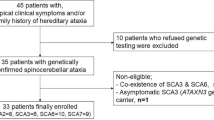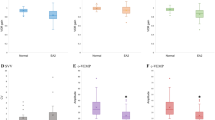Abstract
Spinocerebellar ataxia type 6 (SCA6) is a calcium channelopathy due to a pathological CAG repeat expansion in CACNL1A4. Patients frequently describe paroxysmal vertigo early in the disease course, but it is not clear whether this is central or labyrinthine in origin. To address this issue we studied 21 SCA6 patients. Symptoms of vertigo were defined using a structured questionnaire. Signs were recorded during a standardised bed-side vestibular examination that included systematic positional testing with Frenzel goggles.
Brief, recurrent attacks of vertigo occurred in 13 patients, usually preceding the onset of ataxia. Nystagmus was observed behind Frenzel goggles in 14 patients, and was induced either during positional testing, or head shaking in 20 patients. Only one patient had findings typical of benign paroxysmal positional vertigo (BPPV). Combined downbeat and horizontal gaze-evoked nystagmus (“side-pocket”) was the most common form, occurring most commonly in supine and head-hanging positions, and following horizontal head-shaking. Nystagmus beating away from the ground (apogeotropic) occurred in 9 patients as they lay on their side.
In conclusion, vertigo and abnormalities on bedside vestibular examination are common in SCA6, with forms of nystagmus typical of cerebellar, rather than labyrinthine, disease. These findings demonstrate phenotypic overlap between SCA6 and episodic ataxia type 2, which are both due to mutations in CACNL1A4.
Similar content being viewed by others
References
Zhuchenko O, Bailey J, Bonnen P, Ashizawa T, Stockton DW, Amos C, Dobyns WB, Subramony SH, Zoghbi HY, Lee CC (1997) Autosomal dominant cerebellar ataxia (SCA6) associated with small polyglutamine expansions in the alpha 1A-voltagedependent calcium channel. Nat Genet 15:62–69
Zee DS, Yee RD, Cogan DG, Robinson DA, Engel WK (1976) Ocular motor abnormalities in hereditary cerebellar ataxia. Brain 99:207–234
Gomez CM, Thompson RM, Gammack JT, Perlman SL, Dobyns WB, Truwit CL, Zee DS, Clark HB, Anderson JH (1997) Spinocerebellar ataxia type 6: gazeevoked and vertical nystagmus, Purkinje cell degeneration, and variable age of onset. Ann Neurol 42:933– 950
Leigh RJ, Zee DS (2006) The Neurology of Eye Movements (Book/DVD). Oxford University Press, New York
Yabe I, Sasaki H, Takeichi N, Takei A, Hamada T, Fukushima K, Tashiro K (2003) Positional vertigo and macroscopic downbeat positioning nystagmus in spinocerebellar ataxia type 6 (SCA6). J Neurol 250:440–443
Yabe I, Sasaki H, Yamashita I, et al. (1998) Initial symptoms and mode of neurological progression in spinocerebellar ataxia type 6 (SCA6). Rinsho Shinkeigaku – Clinical Neurology 38:489–494
Takahashi H, Ishikawa K, Tsutsumi T, Fujigasaki H, Kawata A, Okiyama R, Fujita T, Yoshizawa K, Yamaguchi S, Tomiyasu H, Yoshii F, Mitani K, Shimizu N, Yamazaki M, Miyamoto T, Orimo T, Shoji S, Kitamura K, Mizusawa H (2004) A clinical and genetic study in a large cohort of patients with spinocerebellar ataxia type 6. J Hum Genet 49:256–264
Craig K, Keers SM, Archibald K, Curtis A, Chinnery PF (2004) Molecular epidemiology of spinocerebellar ataxia type 6. Ann Neurol 55:752–755
Brandt T, Dieterich M, Strupp M (2005) Vertigo and Dizziness: Common Complaints. Springer, New York
Garnham L, Sloper JJ (2006) Effect of age on adult stereoacuity as measured by different types of stereotest. Br J Ophthalmol 90:91–95
Walker MF, Zee DS (2005) Cerebellar disease alters the axis of the high-acceleration vestibuloocular reflex. J Neurophysiol 94:3417–3429
Marti S, Palla A, Straumann D (2002) Gravity dependence of ocular drift in patients with cerebellar downbeat nystagmus. Ann Neurol 52:712–721
Pierrot-Deseilligny C, Tilikete C (2008) New insights into the upward vestibulo- ocular pathways in human brainstem. Progress in Brain Research 171:509–518
Levy NS, Glick EB (1974) Stereoscopic perception and Snellen visual acuity. Am J Ophthalmol 78:722–724
Maschke M, Gomez CM, Tuite PJ, Pickett K, Konczak J (2006) Depth perception in cerebellar and basal ganglia disease. Exp Brain Res 175:165–176
Brandt T, Strupp M (1997) Episodic ataxia type 1 and 2 (familial periodic ataxia/vertigo). Audiol Neurootol 2:373–383
Geschwind DH, Perlman S, Figueroa KP, Karrim J, Baloh RW, Pulst SM (1997) Spinocerebellar ataxia type 6. Frequency of the mutation and genotype- phenotype correlations. Neurology 49:1247–1251
Jen J, Kim GW, Baloh RW (2004) Clinical spectrum of episodic ataxia type 2. Neurology 62:17–22
Jen JC, Yue Q, Karrim J, Nelson SF, Baloh RW (1998) Spinocerebellar ataxia type 6 with positional vertigo and acetazolamide responsive episodic ataxia. J Neurol Neurosurg Psychiatry 65:565–568
Marti S, Straumann D, Buttner U, Glasauer S (2008) A model-based theory on the origin of downbeat nystagmus. Exp Brain Res 188:613–631
Author information
Authors and Affiliations
Corresponding author
Rights and permissions
About this article
Cite this article
Yu-Wai-Man, P., Gorman, G., Bateman, D.E. et al. Vertigo and vestibular abnormalities in spinocerebellar ataxia type 6. J Neurol 256, 78–82 (2009). https://doi.org/10.1007/s00415-009-0068-2
Received:
Revised:
Accepted:
Published:
Issue Date:
DOI: https://doi.org/10.1007/s00415-009-0068-2




